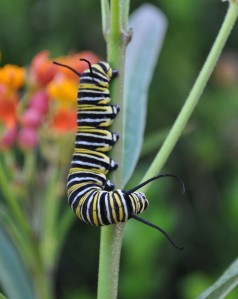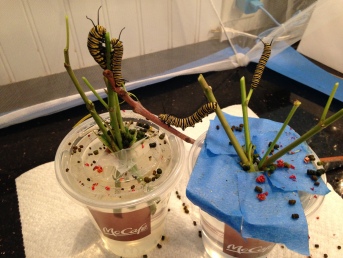
This past spring I witnessed the beauty and mystery of monarch butterflies in my garden. At first, I was skeptical any would flutter by. How would they find my two small milkweed plants?
When they did find it, I was concerned about my lack of ability and time to raise them. Now that I’ve come out the other end, I can say for certain that with a little guidance and effort, anyone can do this. And it’s worth the effort!
As autumn approaches, the western monarch butterflies migrate south, from parts of Northwestern US to various forests along the coast in California, where they overwinter, bundling together to stay warm for survival.
This is not the season for raising monarchs, but rather, it’s a time for preparing your milkweed for the spring mating season and migration back north. You may also choose to buy more mature milkweed plants in early spring.
The western migration pattern for the monarchs differ from the more well-documented eastern migration from Canada and northern United States to the oyamel forest in Mexico. Though the butterfly species are the same, the ones on the West Coast overwinter in different areas than their eastern counterparts.
The overwintering sites are at their peak from about October-February. There are hundreds along the California coast, from Mendocino County to San Diego. According to Dr. Francis Villablanca, Professor of Biological Sciences at Cal Poly, San Luis Obispo, Director and research advisor for Monarch Alert, “Two of the most spectacular sites are Elwood Main in Santa Barbara, and Pismo Beach State Park.” Another popular site is around the Pacific Grove Museum. For more information, visit: xerces.org/where-to-see-monarchs-in-california/
But if you would like to experience monarchs in your own home, begin by growing milkweed in your garden. By spring they should be full and at least 1.5 feet tall (or purchase two or more 5-gallon container plants). This way, the monarch larvae have plenty to eat. Native varieties are best. But an easier plant to maintain is the tropical milkweed. It’s a beautiful water-wise plant, too — though poisonous to ingest, like most milkweed. Just make sure to cut it down during the off season (starting in late July and August) to help minimize passing on disease to future monarchs and allowing for a more natural migration pattern.

When spring comes, the overwintering monarchs will be ready to mate and head north. Their migration is truly a unique phenomenon that is still a mystery to many scientist. It will take at least 3 generations of monarchs and about 4 months to make it all the way up. And it is during this time when the monarch-raising fun begins!
1) In late spring especially, stay vigilant every day (even just 15 minutes in the afternoon), visiting your milkweed plant, killing aphids with a swab on a stick dipped in alcohol, and watching for drifting monarchs. Chances are, these monarchs will land on your milkweed and leave eggs behind. If you’re patient and watch closely, you may even see the monarch actually lay the egg. When I first encountered this, I was moved by the life that was being formed before my very eyes! When you see a white ellipsoid dot on a green stem, you’ve got an egg.
2) 3-4 days later, a tiny caterpillar (larva) will emerge. Keep searching for them daily under leaves and near flowers. When you find one, cut off a small area of the plant, where the larva is hanging on for dear life and bring it in. Be warned… I wanted the larva to live naturally in the garden; but for me, that meant 100% of them being eaten by predators! I was so sad because I felt like the worst monarch mommy. It was time to bring in new hatchlings. And if your plant is healthy, 100% of your larva could successfully emerge as butterflies!
(Note: You may not have time to take care of caterpillars; don’t panic! Just having the milkweed to feed passing monarchs is good! And if you have eggs, you can try to leave them in the garden. You may not have especially dangerous caterpillar snatchers like I did! But if you bring them in…)

3) I put the cut plant (like a straw) into a water-filled plastic cup with a lid, like the ones you get at coffee shop. This helps keeps the plant fresh.
4) I covered the cup/plant/larva with a mesh picnic dome. Whenever the plant looked munched down to nubs, I replaced the plant and gently allowed the caterpillar to crawl onto the new plant. Note: the larva goes through about 5 instars, shedding it’s skin and emerging bigger each time.
In the last few days the larva eat so much, you need to clean their area (to reduce disease) and replace the demolished plant nearly every 18-24 hours. This took the most time in the monarch raising process. Note: Cleaning requires removing the frass (larva excrement) and wiping the flat surface with a natural disinfectant like an equal parts vinegar and water mixture.
5) After the larva can eat and grow no more, they inch their way to the top of your dome and hang upside down in a “J” shape. Try not to disturb the larva from here on! After about a day or two, they will do a circular dance while hanging upside-down. Within minutes a chrysalis will form around the larva. If you happen to catch this process, you will be amazed by the instant transformation. 
6) For the next 10 days or so, a dramatic and amazing transformation is taking place inside the chrysalis. (I even felt like my monarchs were teaching me life lessons… Like sometimes I need to slow down in order to experience deep change… but that’s another article.)
7) When the butterfly is ready to emerge, the chrysalis turns black and then translucent. The shell cracks open and moist wings unravel while fluid is gradually pumped into them,expanding as they dry. Within 10 minutes to a couple hours, the monarch is ready to take flight. You may want to admire the beautiful creature for a day or so; but whatever you do, release it (preferably in the morning or the cool of the day, not at night).

8) Often they land on your hand or clothing, as if to say “thank you” before their final goodbye. And when they leave, you ‘ll feel proud knowing you’ve saved a life and helped the great monarch migration, a natural phenomenon that is still being studied and understood. (Stay tuned for my next post about the monarch migration as it appears in The Quarterly magazine, Fall issue.)
Please share your monarch adventures or misadventures here. I will do my best to answer your questions; but honestly, I am barely scratching the surface on raising monarchs. For a more detailed look into caring for monarchs, try visiting sites like http://monarchbutterflygarden.net and borrowing related books from your local library.
If you’re not sure whether or not you’re ready to raise monarchs, consider the benefits (invite a lovely display of nature into your home, plant a water-wise garden with milkweed, become a feeding and breeding way station for migrating monarchs, produce much needed pollinators, help save the monarch migration and the monarch itself…) These far outweigh the costs.
Note: Photos are by yours truly. I hope you enjoy them!
Ann! I love this. I also love how fast your little cats are chewing up that milkweed. I have seven plants outside, completely bare…time to go to the nursery!
LikeLike
That’s wonderful, Melanie! Chewed up plants = vibrant caterpillars 🙂 Keep up the good work and save the monarchs! Just this morning I heard from Monarch Watch that these wonderful creatures may go on the endangered species list all too soon. So you are doing a worthy thing by planting milkweed (the only food source for monarchs and lacking everywhere because of herbicides).
LikeLike